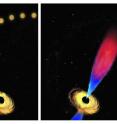Scientists spot jets from supermassive black hole snacking on a star
Related images
(click to enlarge)
Scientists have discovered a hungry black hole swallowing a star at the centre of a nearby galaxy. The supermassive black hole was found to have faint jets of material shooting out from it and helps to confirm scientists' theories about the nature of black holes.
The discovery was published today in the journal Science.
Astrophysicist Dr Gemma Anderson, from the Curtin University node of the International Centre for Radio Astronomy Research (ICRAR), said a supermassive black hole swallowing a star is an extreme event in which the star gets ripped apart.
"It's very unusual when a supermassive black hole at the centre of a galaxy actually eats a star, we've probably only seen about 20 of them," she said.
"Everything we know about black holes suggests we should see a jet when this happens but until now they've only been detected in a few of the most powerful systems.
"Now we've finally found one in a more normal event."
The discovery is the first time scientists have been able to see both a disk of material falling into a black hole, known as an accretion disk, and a jet in a system of this kind.
ICRAR astrophysicist Dr James Miller-Jones compared the energy produced by the jets in this event to the entire energy output of the Sun over 10 million years.
He said it was likely all supermassive black holes swallowing stars launched jets but this discovery was made because the black hole is relatively close to Earth and was studied soon after it was first seen.
The black hole is only 300 million light years away from us and the team (led by Dr Sjoert van Velzen from The Johns Hopkins University in the USA) were able to make their first observations only three weeks after it was found.
"We've shown that it was just a question of looking at the right time and with enough sensitivity," Dr Miller-Jones said.
"Then you can show that a jet exists right at the point you think it should."
Dr Anderson began the research while working with the 4 PI SKY team at Oxford University but moved to Western Australia in September.
She said the event was first picked up by the All-sky Automated Survey for Supernovae (ASAS-SN), which is pronounced 'assassin' by astronomers, and followed up with the Arcminute Microkelvin Imager (AMI), a radio telescope, located near Cambridge.
"Hopefully with the increased sensitivity of future telescopes like the Square Kilometre Array we'll be able to detect jets from other supermassive black holes of this type and discover even more about them," Dr Anderson said.
Source: International Centre for Radio Astronomy Research
Articles on the same topic
- Event Horizon Telescope reveals magnetic fields at Milky Way's central black holeThu, 3 Dec 2015, 20:00:04 UTC
- Earth-sized telescope finds clue to black hole growthThu, 3 Dec 2015, 19:59:44 UTC
- Scientists get first glimpse of black hole eating star, ejecting high-speed flareThu, 26 Nov 2015, 19:43:28 UTC
Other sources
- Monster Black Hole Eats Star, Returns Leftoversfrom Live ScienceFri, 4 Dec 2015, 5:01:48 UTC
- Event Horizon Telescope reveals magnetic fields at Milky Way's central black holefrom Science DailyFri, 4 Dec 2015, 0:42:38 UTC
- Milky Way's Giant Black Hole Probed Like Never Beforefrom Space.comThu, 3 Dec 2015, 22:15:39 UTC
- Magnetic fields detected near black hole at Milky Way centerfrom UPIThu, 3 Dec 2015, 21:52:05 UTC
- Magnetic fields detected near black hole at Milk Way centerfrom UPIThu, 3 Dec 2015, 21:13:30 UTC
- Earth-Sized Telescope Finds Clue to Black Hole Growthfrom Newswise - ScinewsThu, 3 Dec 2015, 20:41:40 UTC
- Globe-spanning telescope array glimpses magnetic field around Milky Way’s black holefrom Science NOWThu, 3 Dec 2015, 19:41:36 UTC
- Event Horizon Telescope reveals magnetic fields at Milky Way's central black holefrom PhysorgThu, 3 Dec 2015, 19:10:48 UTC
- The jet of a black hole drives multiple winds in a nearby galaxyfrom PhysorgWed, 2 Dec 2015, 11:22:58 UTC
- Monster Black Hole Eats Star, Returns Leftoversfrom Space.comTue, 1 Dec 2015, 17:00:24 UTC
- Black Hole Devours and Destroys | Space Wallpaperfrom Space.comMon, 30 Nov 2015, 21:00:11 UTC
- NASA image: A precocious black holefrom PhysorgMon, 30 Nov 2015, 11:20:15 UTC
- Scientists Watch Black Hole Have Leisurely Mealfrom MSNBC: ScienceSat, 28 Nov 2015, 1:00:36 UTC
- Secrets of a Supermassive Black Hole Revealed | Space Wallpaperfrom Space.comSat, 28 Nov 2015, 0:00:13 UTC
- Scientists get first glimpse of black hole eating star, ejecting high-speed flarefrom Science DailyFri, 27 Nov 2015, 19:40:16 UTC
- Astrophysicists observe black hole eating star, ejecting flarefrom UPIFri, 27 Nov 2015, 19:00:21 UTC
- Scientists get first glimpse of black hole eating star, ejecting high-speed flarefrom Science BlogFri, 27 Nov 2015, 19:00:17 UTC
- Scientists get first glimpse of black hole eating star, ejecting high-speed flarefrom Science DailyFri, 27 Nov 2015, 18:10:51 UTC
- Scientists Get First Glimpse of Black Hole Eating Star, Ejecting High-Speed Flarefrom Newswise - ScinewsThu, 26 Nov 2015, 19:40:07 UTC
- Scientists get first glimpse of black hole eating star, ejecting high-speed flarefrom PhysorgThu, 26 Nov 2015, 19:20:11 UTC

